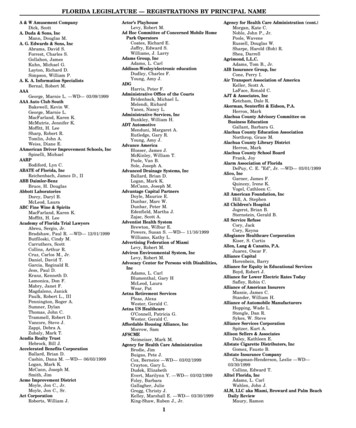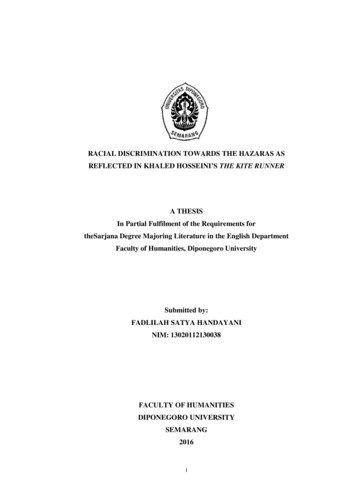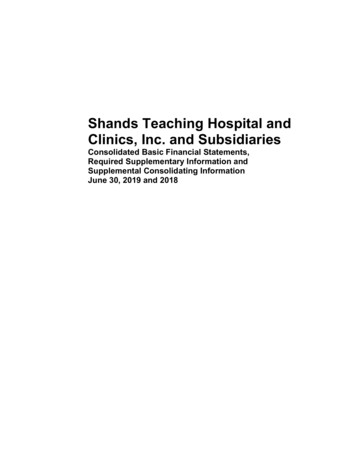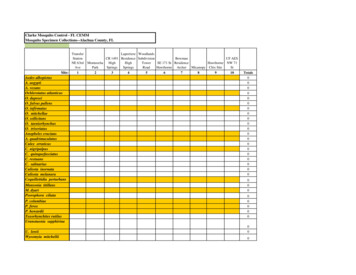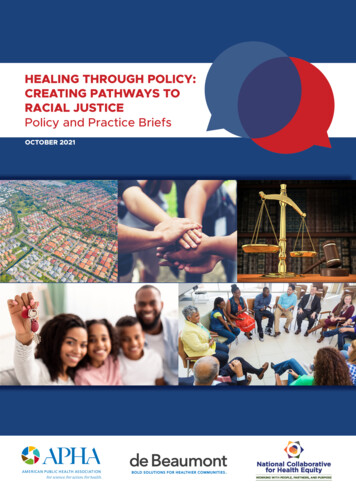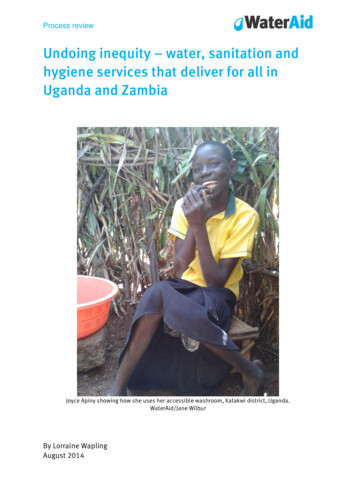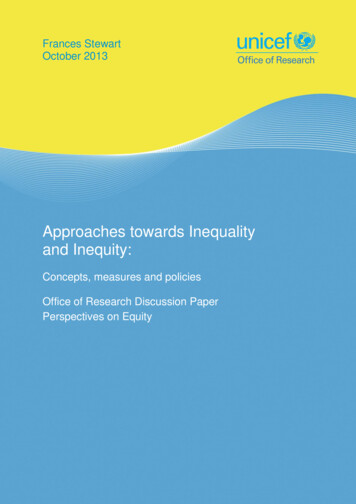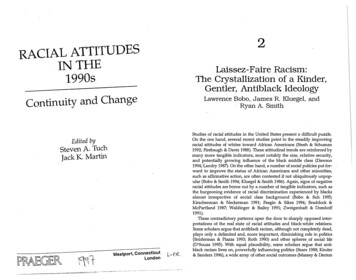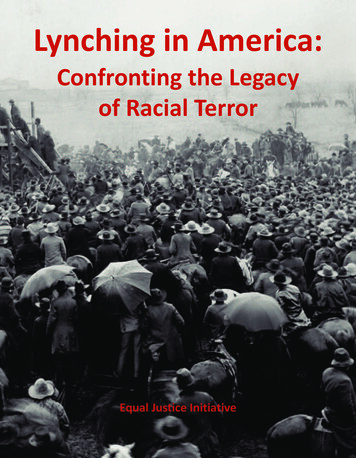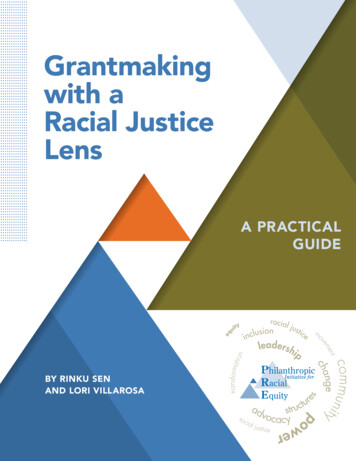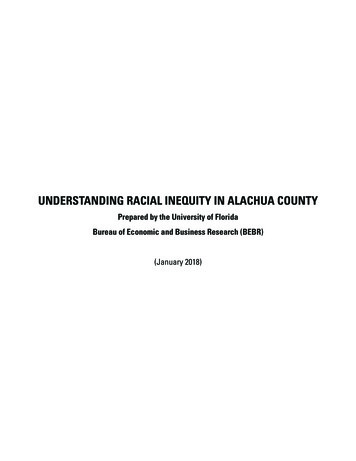
Transcription
UNDERSTANDING RACIAL INEQUITY IN ALACHUA COUNTYPrepared by the University of FloridaBureau of Economic and Business Research (BEBR)(January 2018)
Contents of ReportForeward. . . . . . . . . . . . . . . . . . . . . . . . . . . . . . . . . . . . . . . . . . . . . . . . . . . . . . . . . . . . . . . . . . . . . . . . . . . . . 4Section I: Introduction . . . . . . . . . . . . . . . . . . . . . . . . . . . . . . . . . . . . . . . . . . . . . . . . . . . . . . . . . . . . . . . . . 5Section II: Alachua County’s Population. . . . . . . . . . . . . . . . . . . . . . . . . . . . . . . . . . . . . . . . . . . . . . . . . . 8Section III: Racial Inequity in Alachua County. . . . . . . . . . . . . . . . . . . . . . . . . . . . . . . . . . . . . . . . . . . . 10Section IV: Insights from the Housing, Transportation, and Neighborhood Supplement . . . . . . . . 17Section V: Factors and Forces Behind Racial Disparities in Alachua County. . . . . . . . . . . . . . . . . . 25Section VI: From the Views and Experiences of Minority Groups in Alachua County. . . . . . . . . . . 30Section VII: General Conclusions. . . . . . . . . . . . . . . . . . . . . . . . . . . . . . . . . . . . . . . . . . . . . . . . . . . . . . . 32Data Collection. . . . . . . . . . . . . . . . . . . . . . . . . . . . . . . . . . . . . . . . . . . . . . . . . . . . . . . . . . . . . . . . . . . . . . . 33Appendix A - Data Tables on Disparity Measures. . . . . . . . . . . . . . . . . . . . . . . . . . . . . . . . . . . . . . . . . 35Appendix B - Maps . . . . . . . . . . . . . . . . . . . . . . . . . . . . . . . . . . . . . . . . . . . . . . . . . . . . . . . . . . . . . . . . . . . 89American Alligator at Paynes Prairie, Gainesville, Florida3
FOREWARDFor many years, racial disparities have made an impact on the lives of people in AlachuaCounty, Florida. Many advocacy groups have been working diligently on improving conditionsfor minorities in order to reduce these disparities. A wealth of data exists exemplifying specificareas that may be helpful to these organizations. The following report provides a baseline ofracial disparity data in the county, showing the differences between Whites and four minoritygroups: Blacks, Hispanics, Asians, and Other. With this baseline, future data has the potential toshow changes and trends, illuminating the effects of programs attempting to address the myriad of issues that contribute to these disparities.We hope that the information contained in this report will be informative to residents ofAlachua County and useful to the programs trying to make an impact. We look forward to thepossibility of building on this report in the future with updated data on the indicators includedas well as other indicators that may further shed light on racial inequities.We would like to thank the organizations who commissioned this report for giving usthe opportunity to perform this work: Alachua County, Alachua County Public Schools, Cityof Gainesville, Gainesville Area Chamber of Commerce, Santa Fe College, UF Health, andUniversity of Florida. We would also like to thank the many people who contributed to theeffort necessary to complete the report. Cynthia Clark moderated the focus group, and MarkHouse conducted the one-on-one interviews with community members and experts andcompiled the information from both formats. UF Bureau of Economic and Business Researchstudents and staff including Mark Girson, Hui Hui Guo, Art Sams, Anthony Chen, NelsaVazquez, and others collected data, performed quality control, and managed the project.We would also like to thank the community members and experts who participated inthe focus group and one-on-one interviews, whose involvement made possible the qualitativecomponent of this undertaking.Finally, we appreciate the work of the University of Florida Program for ResourceEfficient Communities research team led by Hal Knowles and Lynn Jarrett, who collected,analyzed and reported on more in depth housing and transportation disparity issues in aseparate volume.Hector H. SandovalProject DirectorUnderstanding Racial Inequity in Alachua County4
SECTION I: INTRODUCTIONRacial inequity is a long-standing issueBusiness Research (BEBR) led this project inin many communities across the Unitedcollaboration with the University of FloridaStates, affecting the opportunities of minorityProgram for Resource Efficient Communitiesindividuals and families. In March 2016, the(PREC). This document contains the mainUnited Church of Gainesville and the Alachuaresults of this effort. Please let us know howCounty branch of the National Association foryou are using the information contained inthe Advancement of Colored People (NAACP)this report by emailing United Way of Northsponsored a weekend-long seminar to focusCentral Florida at research@unitedwayncfl.org.community efforts on inequities in the AlachuaCounty area. The seminar featured speakersfrom the Dane County, Wisconsin Race toEquity Project. This project collected existingnational, state, and local data documentingracial disparities in the county and comparingthose disparities to Wisconsin and the UnitedStates overall. Their study led to a communitywide focus on how their community can worktogether to meet the challenge of narrowingthe gaps in quality of life among all racial andethnic groups.A group of Gainesville, Floridacommunity leaders representing AlachuaCounty, Alachua County Public Schools, Cityof Gainesville, Gainesville Area Chamber ofCommerce, Santa Fe College, UF Health, andUniversity of Florida saw value in completinga similar project. Wishing to understand anddocument racial inequity in Alachua County,this group called for the development of abaseline report grounded in quantitativefindings to document and provide insightsabout the extent, nature, and source ofracial inequality in Alachua County. TheUniversity of Florida Bureau of Economic andMain GoalsAlachua County’s population is 19.8 percentBlack/African American, 9.2 percent Hispanic,and 6.3 percent Asian. The county is hometo two major educational institutions: theUniversity of Florida, the state’s flagshipuniversity and a highly ranked public researchuniversity, and Santa Fe College, winnerof the 2015 Aspen Prize for CommunityCollege Excellence. Both attract top talentand contribute to the racial and culturaldiversity of the region; however, the growingachievement gap between disparate areasof Gainesville has compelled communityleaders to examine racial, social, andeconomic inequality at the local level. Thereis a shared concern that the racial divisionsin Alachua County perpetuate disadvantageand discrimination in many areas such asemployment opportunities, housing andtransportation, public accommodations,education, and public benefits todisenfranchised populations.The purpose of this report is to provide acomprehensive picture of the disparities in5
Alachua County between each of the minorityexperts in racial inequity on each of thegroups and Whites on several dimensionsfollowing topics: economic well-being,of human well-being, and to compare raceeducational achievement, family structure,and ethnicity disparities in Alachua Countychild welfare involvement, involvement in theto Florida and the nation. By gaining ajustice system, health status, and housing andmore thorough understanding of this issue,transportation. Conditional on the availabilitycommunity leaders will be better equipped toof data, the outcome of this consultationinfluence institutional awareness, make policyresulted in the collection of 50 differentrecommendations and support initiatives thatindicators. For each indicator, the most recenttackle the causes of these problems, resultingdata were gathered for Whites as well as eachin a reduction in these disparities.minority group: African-American, Asian,MethodologyTo compile a comprehensive databased picture of the racial disparities inAlachua County and to gain a deeperunderstanding of these disparities, BEBRutilized both a quantitative and qualitativeapproach. The collection of quantitativedata provides a standardized method ofcomparison across the different minoritygroups. The qualitative data supplements thequantitative data by providing informativeperceptions, experiences, and concerns ofAlachua County minority residents as well asthe expertise of scholars in racial disparity.We first collected data on a wide rangeof indicators representing several aspects ofhuman well-being to provide a quantitativebaseline of racial disparity in Alachua County.To accomplish this task, we consulted withHispanic, and a combined group of all otherraces. We compared each of the minoritygroups to the non-Hispanic White populationin Alachua County, and calculated a disparityratio to measure racial disparities.1Second, a focus group with Black/African-American residents of AlachuaCounty was conducted. The goal of this partof the project is to assess the perceptions,opinions, and experiences of Black residentsin the context of racial inequity. During thefocus group, a series of slides were shownthat detailed the extent and nature of racialdisparities in the area. These slides showeddata collected on the seven dimensionsmentioned above to motivate the discussion.In general, the participantsacknowledged that they face inequality on adaily basis. In particular, they mentioned that1The disparity ratio is the value of an indicator for a particularminority group at a particular geographic level divided by thevalue of the same indicator for non-Hispanic Whites at thesame geographic level. For some indicators, because we wereunable to identify the non-Hispanic White population, the6ratio was calculated using the White population.
the history of racism is an important factorContentcontributing to the disparities and that currentdisparities in the education system and inSection II provides a snapshot oftheir interactions with law enforcement arethe population in Alachua County. Sectionprominent and play an important role.III portrays the picture of racial disparityin Alachua County as illustrated by theThird, a total of 10 one-on-onequantitative data. Section IV contains ainterviews were conducted. Three interviewssample of the main results and insightswere conducted with county residents fromfrom the housing, transportation, andminority groups other than African-Americans. neighborhood supplement. Section VThe remaining seven interviews were withdescribes the factors and forces behind theexperts in local and national racial disparitiesracial disparities in the county as describedfrom the University of Florida. Similar toby the experts we interviewed. Section VIthe focus group, we asked for respondents’summarizes the findings derived from ouropinions on the picture portrayed by theinteraction with the minorities through thequantitative data to understand the causesfocus group and the one-on-one interviews.and potential solutions to racial disparities inThe last section concludes and highlights twoAlachua County. The residents agreed withpotential areas that can contribute to reducingthe views and experience of the African-the disparities. Appendix A contains the tablesAmericans that participated in the focusand figures from the main report. Appendixgroup. The experts provided important insightB contains several heat maps showing theinto the factors and forces behind raciallocation where minority groups reside, thedisparities in Alachua County.areas where poverty is concentrated, andFinally, PREC developed a separate,areas of greater concern within the county.more in-depth supplemental module onhousing, transportation, and neighborhoodsto expand our understanding of racial inequityin these areas. This module compiles a seriesof housing, transportation, and neighborhoodindicators. Their research serves to shedlight on the presence, depth, and breadth ofhousehold- and lifestyle-related inequalitiesacross major racial and ethnic demographicgroups within Alachua County. This reportcontains some of their main findings. Thecomplete PREC report is also available.7
SECTION II: ALACHUA COUNTY’S POPULATIONThe total population of Alachua Countyother race, or two or more races. The second2interviewed.SectionVI 70.1summarizesthe arefindings derivedfrom ourinteractionwith thethroughis 259,964. Of those identifiedthe focus group and the one-on-one interviews. The last section concludes and highlights two potentialas Hispanic, which corresponds to almost 9.2areas that can contribute to reducing the disparities. Appendix A contains the tables and figures from theHispanicWhite,for 161,443percenttheoflocationthe totalpopulationin thecounty.4mainreport.accountingAppendix B containsseveral people.heat maps showingwhereminority groupsreside,the areaswhere povertyconcentrated,and areas ofBetweengreater concernthe county.The largestminoritygroupisinAlachua County2005withinand 2015,Alachua County hasWhite. More specifically, 62.1 percent are non-are African-Americans,3 composing nearly 20II. Alachua County’s Populationpercent of the total population, or equivalentlyexperienced a decrease in the fraction of nonHispanic White, accompanied by an increase2total Aroundpopulation6.3of percentAlachua CountyOf thattotal,percentandare Asians.White. More51,528Thepeople.of the is 259,964.in theshareof 70.1Hispanicsspecifically, 62.1 percent are non-Hispanic White, accounting for 161,443 people. The largest minority3populationAsian,or about16,280 people.group arein AlachuaCountyare African-Americans,composing nearly 20 percent of the total population, orComparedandpeople.the U.S.,equivalently9,81951,528people. Around6.3 percent of the populationare Asian,toor Floridaabout 16,280TheThe remainingindividuals,whoremaining 9,819 individuals, who correspond to 3.8 percentof thepopulation,are identifiedaAlachuaCountyis composedofasa havinghighercorrespondto 3.8 percent of the population,different race, such as American Indian or Alaska Native, Native Hawaiian or Other Pacific Islander, somefraction of African-Americans and Asians, andare identifiedasorhavinga differentsuchother race,two or moreraces. Therace,secondlargest minority group are those identified as Hispanic, whicha lowerfractionof Hispanics.Around16.2correspondsto almost9.2 percentof theNativetotal populationin the county.Between2005 and 2015,Alachuaas AmericanIndianor AlaskaNative,County has experienced a decrease in the fraction of non-HispanicaccompaniedinbyFloridaan increasepercent of White,the populationandin12.6Hawaiian or Other Pacific Islander, some4the share of Hispanics and Asians.Alachua County Population Distribution 2006, 2010 and AsianOtherHispanicSource: U.S. Census Bureau, American Community Survey (ACS) 1-year estimates.22Accordingto the singleestimatesof the U.S.Censusdifferentconcepts.Race is definedas a person’sselfAccordingto theyearsingleyear estimatesof theU.S. CensusbeBureauAmericanCommunitySurvey 2015.The officialBureau American2015.ofTheofficialBureau of Economicidentificationone ormore socialgroups.An individualestimate Communitycalculated ch(BEBR)for 2015wasTheestimatewas not Bureauused becausea completebreakdownby Blackrace isornotavailable,and of Florida’sofcan reportas hthe data collectedacrossEconomicand Business(BEBR) for2015thewasseven dimensions.American Indian or Alaska Native, Native Hawaiian or Other3The terms “Black” and “African-American” are used interchangeably.Pacific Islander, some other race, or with multiple races.The U.S. Census Bureau considers race and ethnicity to be different concepts. Race is defined as a person’s selfbreakdown by race is not available, and to keep consistencyEthnicity describes whether a person is of Hispanic origin oridentification with one or more social groups. An individual can report as White, Black or African American, Asian,with the Americandata anicsmayreportasoranyrace,for example,Indian or Alaska Native, Native Hawaiian or Othernot,Pacificsomeotherrace,withmultipleraces. as3The terms“Black”and ribeswhether a person areis ofusedHispanic origin orHispanic-White,not, and Hispanicsmay report asetc.any race, for example,as Hispanic-White, Hispanic-Black, etc.interchangeably.URL: hnicity-onepager.pdfThe U.S.URL:CensusBureau considers race and ethnicity toethnicity-onepager.pdf254,893. Thelatter estimate was not used because a complete486
percent in the U.S. are identified as Blacks.Around 2.7 percent of the population areAsians in Florida and 5.4 percent in the U.S.Almost one-quarter of Florida’s population isidentified as Hispanics, while only 17.6 percentin the U.S.A large proportion of the county’spopulation is of working age. Around 23.6percent of the population in Alachua Countyare under age 20, around 63.5 percent arebetween 20 and 64 years, and the remaining12.8 percent are age 65 and older. Althoughthe median5 age of Florida’s population isincreasing, with a median age of 41.8, Alachuais among the counties aging less rapidly, witha median age of 31.1;6 however, within thecounty, the median ages vary by race andethnicity. The median age for non-HispanicWhites is 35, for Blacks is 28.2, for Asians 25.9and Hispanics 25.1.Clock Tower, Gainesville, Florida5Median is the point at which 50 percent are below and 50percent are above.6U.S. Census Bureau, 2015 American Community Survey(ACS) 1-year Estimates9
SECTION III: RACIAL INEQUITY IN ALACHUA COUNTYWe collected data to compare theEconomic well-being is a concern forperformance of Alachua County minorityall people. For almost all households in thegroups to that of the non-Hispanic Whiteeconomy, the sale of their labor servicespopulation on a total of 50 different indicatorsprovides their major source of income. Asthat capture several aspects related to humana result, losing or not being able to find awell-being, such as economic well-being,job can severely harm a family’s economiceducation, family structure, child welfare,well-being. Some races are more likelyinvolvement with the justice system, health,than others to experience this difficulty. Theand housing. These measures provideunemployment rate for Blacks in Alachuainsight into the status of local minoritiesCounty is 14.7 percent, with 7.8 percent foras contrasted with the non-Hispanic WhiteHispanics and 8.5 percent for Asians. Bypopulation in the county.7contrast, the unemployment rate for non-In general, this data shows AfricanAmericans do not fare as well as the nonHispanic White population in Alachua County,particularly in terms of economic well-being,their interaction with the justice system,education, and access to healthcare. Thesame is true for the Hispanic populationfor the economic well-being and educationmeasures. In contrast, Asians outperformthe non-Hispanic White population in anumber of measures, particularly in educationperformance and attainment.8 Additionally,Hispanic Whites is 5.8 percent. Calculatedas a disparity ratio, this means that AfricanAmericans in the county are almost 2.5 timesmore likely to be unemployed than their nonHispanic White peers. Similarly, Asians andHispanics are approximately 1.5 times morelikely to be unemployed. Although thesedisparities exist within Alachua County, Blacksand Hispanics in Alachua County have lowerunemployment rates than these minorities inthe state of Florida overall.The differences in employmentcompared to the state and the nation as aopportunities within the county for Blacks andwhole, African-Americans in the county fareHispanics contribute to the already importantworse. Specifically, greater disparities wereincome disparities. Although the non-Hispanicfound in measures related to economic well-White population in Alachua County has abeing, education performance and attainment,higher median household income ( 51,740)and involvement with the justice system.than any other group, this income is below the7The data collection period took place during the spring andsummer of 2017.8According to the 2011-2015 American Community Survey(ACS) 5-year estimates, the percentage that have a bachelor’sdegree or higher is around 73.3 percent for Asians, 46.210percent for non-Hispanic Whites, 39.7 percent for Hispanics,and 16.3 percent for African Americans.
state and national levels. More than half of theCompared to the median householdnon-Hispanic White households in the countyincome for Blacks and Hispanics at themake more than 50,000 annually. Asiansstate and national level, the minorities inhave a median household income of 47,236;Alachua County are also making less. Forhowever, their income is much lower thanexample, the median household income fortheir state and nationwide peers. ImportantBlacks in Florida is 34,664 and in the U.S.income disparities appeared when lookingis 35,695, and more than one-third of theat the incomes of Blacks and Hispanics.Black households in Florida and in U.S. haveThe median household income for Blacks isincome greater than 50,000, compared towithin Alachua County, Blacks and Hispanics in Alachua County have lower unemployment rates than 26,561,whichis equivalentpercentthe one-quarter in Alachua County. A similartheseminoritiesin the statetoof 51Floridaoverall.ofthe patternfor Hispanicsthe HispanicpopulationinThe differencesin employmentwithin thecounty isforfoundBlacks andcontributeto thealreadyimportantincomehouseholdsdisparities. AlthoughWhite population in Alachua County hasonly 25.7percentof Blackhave the non-Hispanicthe county.a higher median household income ( 51,740) than any other group, this income is below the state andnational levels. More than half of the non-Hispanic White households in the county make more thanThese income disparities arefor Hispanicsthe medianincome 50,000 annually.Asianshouseholdhave a medianhousehold income of 47,236; however, their income is muchaccompaniedby appearedhigher povertyratesforloweraroundthan their62stateand nationwidepeers.income disparitieswhen lookingat9theis 32,105,percentof that oftheImportantincomes of Blacks and Hispanics. The median householdincomeforBlacksis 26,561,whichisequivalentBlacks and Hispanics. More concretely, 35.7non-HispanicWhites,only 34.3percentto 51 percentof theandnon-HispanicWhiteincome.ofAdditionally, only 25.7 percent of Black households havepercentof AfricanAmericansand 31.2percentan incomegreater than have 50,000.Similarly,for Hispanicsthe medianhouseholdincome is 32,105,aroundthe Hispanichouseholdsincomeabove62 percent of that of the non-Hispanic Whites, and only34.3 percentthecountyHispaniclivehouseholdsof Hispanicsinofthebelowhavethe 50,000.income above 50,000.an income greater than 50,000. Similarly,poverty line. By contrast, the non-HispanicThousandsMedian Household Income in 2015 (thousands of dollars) 80 74.2 70 60 61.9 51.7 47.2 50 40.9 40 30 59.5 52.5 26.6 32.1 34.7 42.7 35.7Non-Hispanic WhiteBlackAsianHispanic 20 10 0AlachuaFloridaUSASource: U.S. Census Bureau, American Community Survey (ACS) 5-year estimates.BlacksHispanicsat the statelevel, the 6565;and 14,326for a householdof andtwo nationalwith a ess.Forexample,themedianhouseholdincomeforrelative poverty threshold (poverty line) is considered to beyears or older with no children, and 24,036 for Blacksa family ofinFloridais 34,664andintheU.S.is loridain poverty. The poverty thresholds are income dollar amountsfour with two children under age 18. The poverty thresholdsand in U.S. have income greater than 50,000, compared to the one-quarter in Alachua County. A similarthat vary according to the size of the house and the ages of its are updated annually, available here: https://www.census.pattern is found for the Hispanic population in the county.members accounting for the minimum level of resources that storical9to the medianhouseholdincomeforAnyoneComparedliving in a householdwith anincome belowtheirare adequateto incomemeet basicneeds. In are2015,accompaniedsome of theThesedisparitiespoverty-thresholds.htmlby higherpoverty rates 9 for Blacks and Hispanics. Morethresholdswere: 12,331a singleunder ageand 31.2 percent of Hispanics in the county live below theconcretely,35.7forpercentofindividualAfrican Americans9Anyone living in a household with an income below their relative poverty threshold (poverty line) is considered tobe in poverty. The poverty thresholds are income dollar amounts that vary according to the size of the house andthe ages of its members accounting for the minimum level of resources that are adequate to meet basic needs. In11
times more likely to be in poverty than non-Hispanic White children.Poverty and Child Poverty in 201550%Poverty44.6%Child Poverty38.7%38.3%40%povertyline.35.7%By contrast, the non-Hispanic White poverty rate is 19.7 percent, and for Asians is 24.932.3%percent. Looking into the child31.2%poverty rate, the differences are even29.1% starker for African Americans. The27.5%27.0%30%24.9%in poverty is 44.6 percent. Calculated as a disparity ratio, Black childrenpercent of Black childrenare 3.324.3%21.5%21.6%times 19.7%more likely to be in poverty than non-Hispanic White 12.6%12.9%5.7%0%50% Non-HispanicWhite40%Poverty and Child Poverty in %FloridaAlachuaAsianHispanicChild Poverty38.3%United StatesSource: U.S. Census Bureau, AmericanCommunity Survey (ACS) 5-year estimates.31.2%27.5%30%White poverty rate is 19.724.9%percent, and for21.5%32.3%29.1%27.0%activities during the summer can24.3%lose21.6%19.7%AsiansIncomeis 24.9percent.areLookinginto themonths andof progressmustbe made20%disparitiesclosely relatedto childschool performanceattainment.thatLowerincomenot %of children,but alsothe abilitywhenof parentsto thenutritiondifferencesare vities.Students who do5.7%not partake in enrichment activities during the summer can lose months oflead to important disparities in educationprogress that must be made up when school starts again. These issues can lead to important disparities0%childrenpovertyis in ineducationperformance.For Hispanicexample,the percentageof nNon-HispanicBlackNon-HispanicBlackAsianHispanic ua County27.7 percentandarefor Hispanicsis 59ofpercent,non-HispanicWhites inandreadingAsiansas a disparityratio, isBlackchildren3.3Black whilethirdforgradersproficientUnitedStatesthese levels are 74Alachuaand 88.9 percent respectively.FloridaA similar pattern is observedforeighth gradersSource:likelyU.S.inCensusBureau,American thanCommunity5-year estimates.times moreto bein povertynon-Survey (ACS)in AlachuaCounty is 27.7 percent and forproficientmath.for African Americans. The percent of BlackHispanic White children.Hispanics is 59 percent, while for non-Hispanic Whitesand Asiansincomethese notlevelsIncome disparitiesare re3rd GradersProficientin toReading8th GradersandProficientin MathLowerin 2015Incomedisparitiescloselyaffectsthenutrition ofarechildren,butrelatedalso the ability74ofandparentssupport respectively.after-school vities.Students whonot emonthsofto schoolperformanceanddoattainment.78.6%patternis gressthat must be made up when school starts Lower inincomenot only affects the nutritionpercentageproficientmath.education performance. For example, theof 59.6%Blackinthirdgraders proficient in reading in59.0%60% but also the ability of parents to50.0%of children,AlachuaCountyand45.1%Asians47.1%is 27.7 percent and for Hispanics is 59 percent, while for non-Hispanic Whites40.7% A similar pattern is observed for eighth 36.4%support40%after-school and summer activities.Disparitiesin education not only32.8%proficient in math. 27.7%22.3%Students who do not partakein enrichmentappeared in performance, but also in20%0%100%80%3rd Graders Proficient in Reading and 8th Graders Proficient in Math in huaSource: Florida Department of icWhiteBlackAsianHispanicFloridaSource: Florida Department of Education.129
High School Graduation Rat
Central Florida at research@unitedwayncfl.org. Main Goals Alachua County's population is 19.8 percent Black/African American, 9.2 percent Hispanic, and 6.3 percent Asian. The county is home to two major educational institutions: the University of Florida, the state's flagship university and a highly ranked public research
